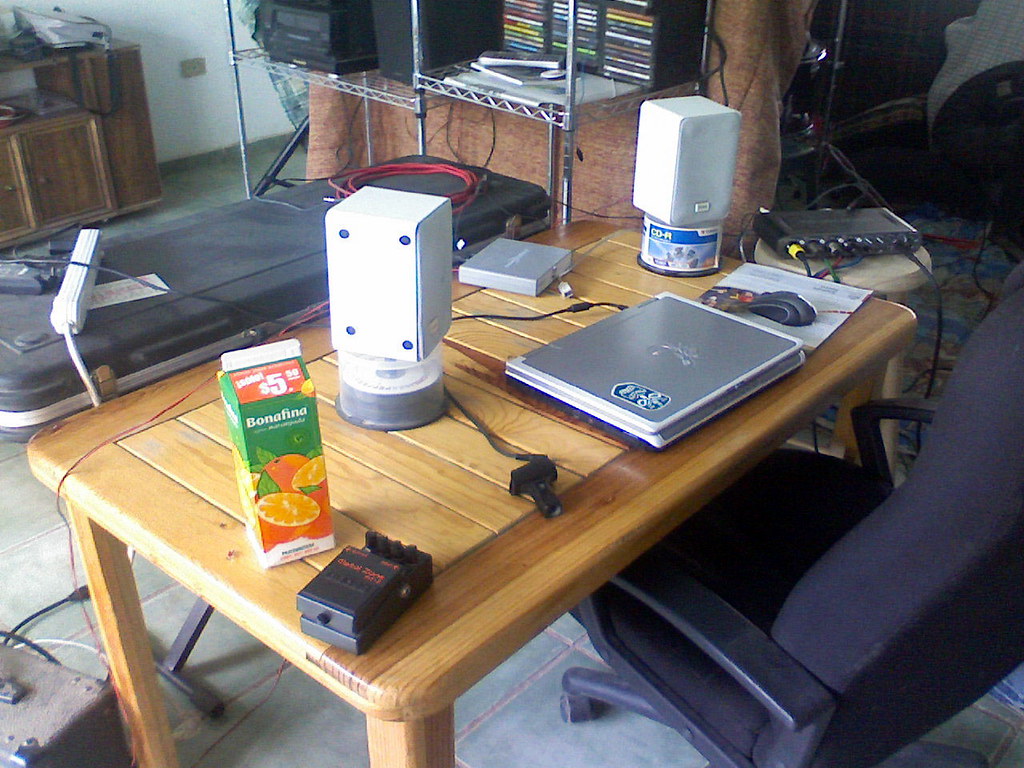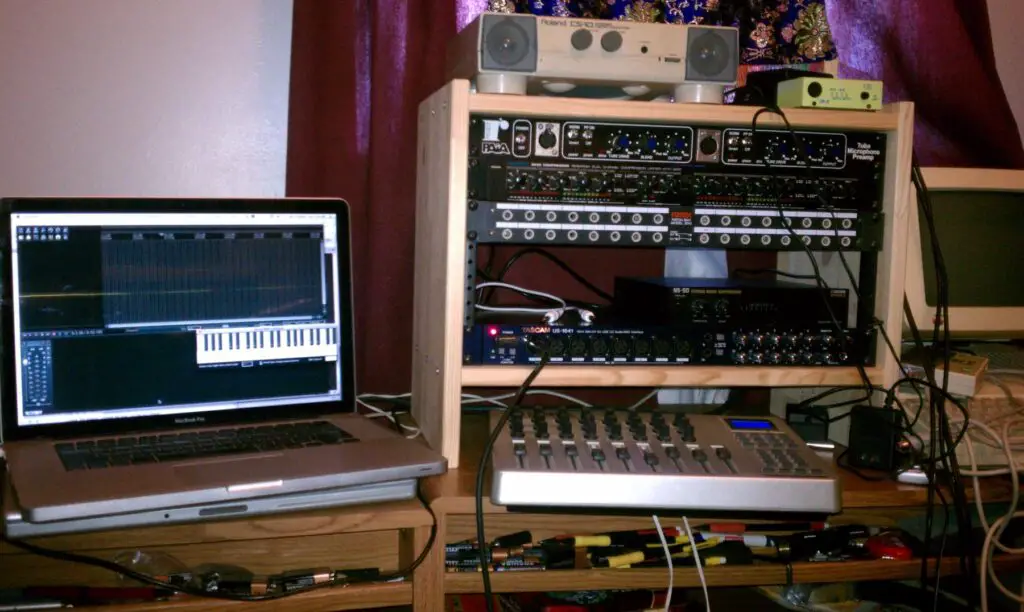Music production on a laptop has become increasingly popular in recent years. With the advancement of technology, it’s easier than ever to create high-quality music from the comfort of your own home. Whether you’re a seasoned pro or just starting out, producing music on a laptop provides a convenient and affordable option. In this Ultimate Guide to Music Production on a Laptop, we’ll cover everything you need to know to get started, from the hardware and software requirements to setting up your home recording studio and optimizing your laptop for music production. So let’s dive in and learn how you can create studio-quality music right from your laptop!
Table of Contents
Introduction
Music production on a laptop is the process of creating music using a laptop computer and music production software. You can record vocals and instruments, edit and mix audio, and add effects and other elements to create a finished track. In today’s digital age, music production on a laptop has become more accessible and affordable than ever. This has opened up opportunities for aspiring musicians and producers who may not have had access to traditional recording studios in the past.
The importance of music production on a laptop lies in the fact that it offers a convenient and cost-effective way to create music. Instead of spending thousands of dollars on expensive studio equipment, you only need a laptop and some software to get started. This makes it possible for anyone to produce high-quality music from the comfort of their own home. Additionally, music production on a laptop allows for greater flexibility and creative control over the music-making process.

Hardware and Software Requirements for Music Production on a Laptop
To create studio-quality music on a laptop, it’s important to have the right hardware and software. In this section, we’ll guide you through the essential components you’ll need to get started.
Choosing the Right Laptop for Music Production
When it comes to music production on a laptop, it’s critical to choose a laptop that meets your needs. Here are some of the key hardware features to consider:
- Processor: Look for a laptop with at least an Intel Core i5 or i7 processor for optimal performance.
- RAM: A minimum of 8GB of RAM is recommended for basic music production, but 16GB or more is ideal for more complex projects.
- Storage: Consider a solid-state drive (SSD) for faster file access and boot times, and choose a laptop with enough storage to accommodate your music files.
- Graphics Card: A dedicated graphics card is optional but recommended for smooth video playback and visual effects.
Here are some of the best laptops for music production currently on the market:
| Laptop | Specifications | Price |
|---|---|---|
| Apple MacBook Pro | 16GB RAM, Intel Core i7 processor, 512GB SSD, AMD Radeon Pro 5300M graphics card | $1,799 |
| Dell XPS 15 | 16GB RAM, Intel Core i7 processor, 512GB SSD, NVIDIA GeForce GTX 1650 graphics card | $1,799 |
| Razer Blade 15 | 16GB RAM, Intel Core i7 processor, 512GB SSD, NVIDIA GeForce RTX 2070 graphics card | $2,299 |
Popular Music Production Software for Laptops
There are many different music production software options available for laptops, each with its own strengths and weaknesses. Here are some of the most popular options:
- Ableton Live: A versatile DAW that’s great for live performance and electronic music production.
- FL Studio: A popular DAW that’s user-friendly and great for beginners.
- Logic Pro X: A powerful DAW that’s widely used in professional music production.
- Pro Tools: A professional-grade DAW that’s widely used in the music and film industries.
- Cubase: A comprehensive DAW that’s great for recording, mixing, and mastering.
- GarageBand: A beginner-friendly DAW that comes free with Mac computers.
Each of these software options has its own unique features and user interface, so it’s important to research and try out different options to find the one that works best for your needs. Remember to choose a software that is compatible with your laptop’s operating system.

Setting Up a Home Recording Studio on a Laptop
If you have the right software and hardware, you can set up a home recording studio on your laptop. Here are some important considerations:
Choosing the Right Workspace and Equipment
When setting up a home recording studio on a laptop, you need a workspace that is comfortable and conducive to creativity. This may be a dedicated room or corner of your home with a desk and a comfortable chair.
Regarding equipment, you must ensure you have everything you need to record and mix your music properly. This may include a microphone, audio interface, headphones, and speakers.
Essential Gear for Home Recording
Besides the equipment mentioned above, some other gear is essential for home recording, such as:
- Pop filter: This helps reduce popping and other unwanted sounds when recording vocals.
- Mic stand: A mic stand can help position your microphone at the right height and angle.
- Shock mount: This helps reduce vibrations and other unwanted noises when recording.
Tips for Creating a Comfortable and Productive Environment
It’s crucial to create a comfortable and productive environment when setting up your home recording studio. Here are some tips to achieve this:
- Choose a quiet space with minimal distractions
- Add comfortable seating and lighting
- Invest in soundproofing materials to reduce outside noise
How to Assemble a Home Recording Studio on a Laptop
Assembling your home recording studio on your laptop involves installing and configuring music production software, connecting your audio interface and other equipment, and setting up your workspace for recording and mixing. Here are the steps to follow:
- Install your music production software of choice, such as FL Studio, Ableton Live, or Logic Pro X.
- Connect your audio interface to your laptop using a USB cable.
- Connect your microphone and headphones or speakers to your audio interface.
- Configure your music production software to use your audio interface as the input and output device.
- Set up your workspace for recording and mixing, using comfortable seating and lighting, and soundproofing materials if necessary.
By following these steps, you can set up a home recording studio on your laptop and start creating high-quality music from the comfort of your own home.

Tips for Optimizing Your Laptop for Music Production
When working on music projects on a laptop, optimizing it for music production can help you get the best performance. Here are some tips to consider:
Adjusting Laptop Settings for Optimal Performance
To optimize your laptop for music production, you need to adjust settings such as power management, audio preferences, and display settings. Adjusting these settings can help improve performance and reduce latency when recording and mixing audio.
Reduce Latency and Optimize Buffer Size
Latency can be a common issue when recording and mixing audio on a laptop. To reduce latency, you can optimize your buffer size and adjust your audio preferences in your music production software. Increasing the buffer size can help reduce the number of times your laptop has to process audio, which can lead to a smoother recording and mixing experience.
Clean Up Your System and Free Up Disk Space
An overloaded hard drive can slow down your laptop’s performance and affect your music production workflow. Regularly cleaning up your system and freeing up disk space can help optimize your laptop for music production. Consider removing any unnecessary files, programs, and applications to free up space and improve performance.
Optimize Your Laptop for Music Production
To optimize your laptop for music production, you can use tools such as disk cleanup and defragmenter to clean up your hard drive and improve performance. Additionally, you can adjust settings in your music production software to reduce latency and improve performance. You can also consider upgrading your laptop’s hardware, such as RAM or hard drive, to enhance its performance.

Techniques for Creating High-Quality Recordings and Mixes on a Laptop
Creating high-quality recordings and mixes on a laptop requires a combination of technical skill and creativity. In this section, we’ll cover some techniques to help you create the best possible recordings and mixes on your laptop.
Recording Vocals and Instruments on a Laptop
When recording vocals or instruments on a laptop, it’s important to use high-quality equipment and set up your workspace properly. Here are some tips to help you get started:
- Choose a quiet room with little to no ambient noise.
- Use a good quality microphone, such as the Shure SM7B or the Audio-Technica AT4053B.
- Use a pop filter to reduce plosive sounds.
- Position the microphone close to the source, but not too close to avoid distortion.
- Use headphones to monitor the recording and avoid bleed from the speakers.
Mixing and Mastering Using Music Production Software
Mixing and mastering are essential steps in the music production process, and can help make your recordings sound polished and professional. Here are some tips to help you mix and master your tracks:
- Use EQ to balance the levels of different frequencies.
- Use compression to control the dynamics of your tracks.
- Use reverb and delay to add depth and dimension to your tracks.
- Use automation to create movement in your mix.
- Use a limiter to prevent clipping and ensure a consistent volume level.
Tips for Achieving Professional-Quality Results
To achieve professional-quality results when recording and mixing music on a laptop, it’s important to pay attention to details such as EQ, compression, and effects. Here are some additional tips to help you achieve professional-quality results:
- Make sure all your tracks are in tune using pitch correction software.
- Use reference tracks to compare your mix to professionally mixed songs.
- Take breaks and come back to your mix with fresh ears.
- Collaborate with other musicians and producers to get feedback on your mix.
Recording and Mixing Tips for Beginners
If you’re new to music production on a laptop, it can be overwhelming to know where to start. Here are some tips and tricks for recording and mixing music on a laptop:
- Start with a simple project and focus on getting a good recording.
- Use headphones to monitor your recording and avoid bleed from the speakers.
- Use EQ and compression sparingly to avoid over-processing your tracks.
- Take breaks to avoid ear fatigue and come back to your mix with fresh ears.
How to Create High-Quality Recordings and Mixes on a Laptop
Creating high-quality recordings and mixes on a laptop requires a combination of technical skill and creativity. By using high-quality equipment, optimizing your laptop for music production, and mastering mixing and mastering techniques, you can create music that sounds polished and professional. Remember to experiment with different techniques and approaches to find what works best for your music.

Best Music Production Software for Laptop
If you’re looking for music production software for a laptop, there are several options to choose from. Here are some of the best:
Ableton Live
Ableton Live is a popular and widely used music production software that offers a variety of tools and effects for recording and mixing music. It is well-known for its intuitive interface and powerful features, making it a favorite among musicians and producers. Ableton Live is suitable for all levels of producers, from beginners to professionals.
FL Studio
FL Studio is another popular music production software that offers a range of features and tools for recording and mixing music. It is known for its ease of use and affordability, making it a great option for beginners. FL Studio is compatible with both Windows and Mac operating systems.
Logic Pro X
Logic Pro X is a popular music production software designed exclusively for Mac users. It offers a range of tools and effects for recording and mixing music. Logic Pro X is known for its intuitive interface and powerful features, making it a favorite among professional musicians and producers.
Pro Tools
Pro Tools is a widely used music production software that is popular among professional musicians and producers. It offers a range of advanced features and tools for recording and mixing music. Pro Tools is a great option for complex music projects and is compatible with both Windows and Mac operating systems.
Cubase
Cubase is a popular music production software that offers a range of tools and effects for recording and mixing music. It is known for its powerful features and intuitive interface, making it a great option for musicians and producers of all levels. Cubase is compatible with both Windows and Mac operating systems.
GarageBand
GarageBand is a free music production software designed exclusively for Mac users. It offers a range of tools and effects for recording and mixing music. While it may not be as powerful as some of the paid options, it is a great starting point for beginners who are just getting into music production.
Choosing the Right Music Production Software for Your Needs
When it comes to choosing the right music production software for your needs, it’s important to consider several factors such as your budget, level of experience, and the complexity of your music projects. Research and try out different options to find the one that works best for you. Keep in mind that many music production software options offer free trials, so take advantage of these to test out the software before committing to a purchase.

Troubleshooting Common Issues in Music Production on a Laptop
Music production on a laptop can be a great way to create music from the comfort of your own home. However, it can also come with its own set of challenges. Here are some common issues that may arise during music production on a laptop:
Common Issues That Arise During Music Production on a Laptop
- Latency: This is the delay between when you play a sound and when you hear it through your headphones or speakers. It can be caused by a slow processor, insufficient RAM, or incorrect buffer settings.
- Audio Glitches: These are audible distortions or interruptions in the sound that can be caused by outdated drivers, insufficient buffer size, or CPU overload.
- Software Crashes: These can occur when your music production software stops working or closes unexpectedly. They can be caused by outdated software, incompatibility issues, or insufficient RAM.
These issues can be frustrating and can affect your music production workflow.
How to Troubleshoot and Resolve Those Issues
To troubleshoot and resolve common issues during music production on a laptop, you may need to:
- Adjust Settings: In your music production software, adjust the buffer size, sample rate, and latency settings to reduce latency and eliminate audio glitches.
- Update Drivers: Make sure your audio drivers are up to date to eliminate audio glitches and improve performance.
- Reinstall Software: If your music production software is crashing frequently, try uninstalling and reinstalling it. This can help resolve compatibility issues and fix any corrupt files.
- Optimize Performance: Close any unnecessary programs or browser windows to free up resources. Consider adjusting your laptop’s power settings to maximize performance during music production.
It’s important to research and try different solutions until you find the one that works best for your specific issue.
Tips for Avoiding Common Issues Altogether
To avoid common issues during music production on a laptop, it’s important to:
- Keep Software and Drivers Up to Date: Regularly check for updates to your music production software and audio drivers to ensure they are running smoothly.
- Optimize Your Laptop for Music Production: Adjust your laptop’s power settings and disable any unnecessary processes or services to maximize performance during music production.
- Regularly Clean Up Your System: Remove any unnecessary files or applications to free up disk space and improve performance.
By following these troubleshooting tips and best practices, you can minimize common issues and enjoy a seamless music production experience on your laptop.

Resources for Improving Your Skills in Music Production on a Laptop
To become an expert in music production on a laptop, it is essential to keep learning and improving your skills. Online courses, tutorials, and communities can be a great way to improve your skills in music production on a laptop. Here are some resources to help you get started:
Online Courses:
-
Udemy: Udemy offers a wide range of courses in music production, from beginner to advanced levels. Some popular courses include “Music Production in Logic Pro X – The Complete Course,” and “Ableton Live 10: Music Production for Beginners.”
-
Lynda: Lynda is another great resource for online courses in music production. They offer courses in a variety of DAWs, including Ableton Live, Logic Pro X, and Pro Tools.
Tutorials:
-
YouTube: YouTube is an excellent resource for tutorials on music production. Some popular channels include “In The Mix,” “Produce Like A Pro,” and “Pensado’s Place.”
-
MusicTech: MusicTech offers a wide range of tutorials on music production, including guides on mixing, mastering, and sound design.
Online Communities:
-
Reddit: Reddit has a variety of communities dedicated to music production, such as r/WeAreTheMusicMakers and r/musicproduction.
-
Gearslutz: Gearslutz is an online community of musicians and producers, offering forums on a range of topics from music production to gear reviews.
By taking advantage of these resources, you can continually improve your skills and become an expert in music production on a laptop.
Conclusion
In conclusion, music production on a laptop is an exciting and accessible way for aspiring musicians and producers to create high-quality recordings and mixes from the comfort of their own homes. By following the tips and techniques outlined in this ultimate guide, you can take your music to the next level and achieve professional-quality results. It’s never been easier to set up a home recording studio on a laptop, and with the right equipment and software, the possibilities are endless.
We hope this guide has been helpful to you in your music production journey. Check out our other content for more tips and resources on home recording, music production software, and hardware. With the right tools and knowledge, you can achieve your music production goals and create amazing music that will be enjoyed by audiences around the world.


